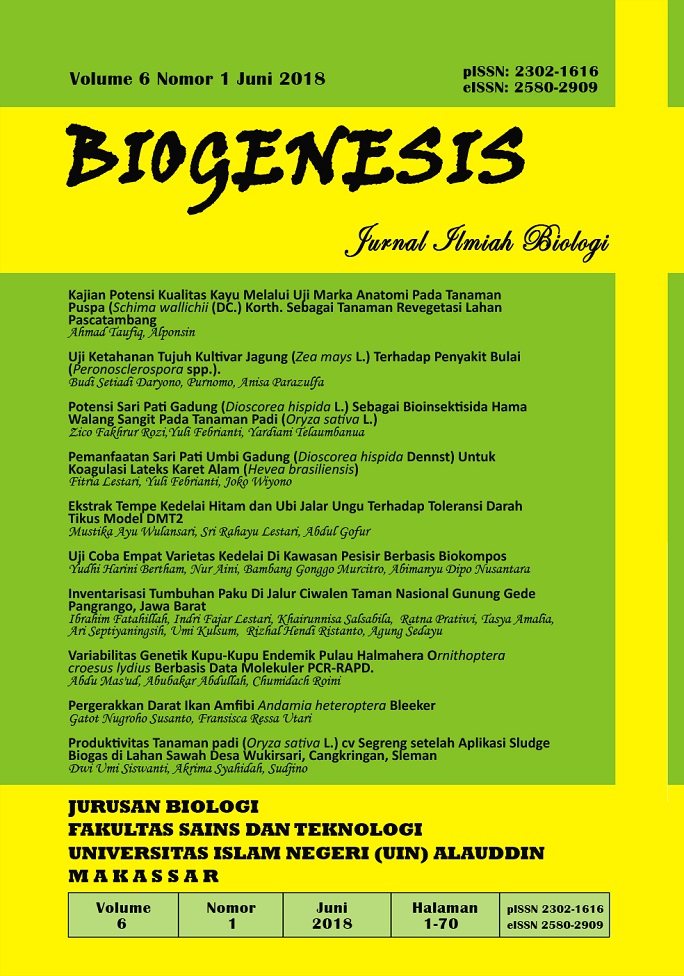Produktivitas Tanaman padi (Oryza sativa L.) Segreng Terhadap Aplikasi Sludge Biogas di Lahan Sawah Desa Wukirsari, Cangkringan, Sleman
Abstract
Rice (Oryza sativa L.) is a main crop agriculture in Indonesia. Biogas sludge is the residue of cattle during processing in the biogas that has lost its gas and rich with macro elements – N, P and K as well as micro elements such as Ca, Mg, Fe, Mn, Cu and Zn. Biogas sludge has not been well utilized by the citizens. This study examined the productivity of rice cultivars Segreng to biogas sludge application on field. The objective of this research was to find the best dose of sludge and to study the productivity of rice cultivars Segreng after sludge application on crop field. Research was conducted in 100 m2 of field. The biogas sludge concentration used in this research was 5 variations; (1) 0 ml, (2) 1000 ml, (3) 2000 ml, (4) 3000 ml, dan (5) 4000 ml. The planting system used is TAJARWO. The productivity parameter measured were Nitrate Reductase Activity (NRA), dry weight, number of grain per plant and grain weight. Environment parameters were temperature, pH, humidity and light intensity. The data was analyzed with ANOVA and followed by DMRT at significant level of 5%. The results revealed that the highest rice productivity was seen in treatment 2000 ml sludge/100m2 with 31 gr of dry weight, 483 number of grains per plant and 30.000 kg/100m2 of grain weight. The best sludge dose present on 2000 ml/100m2.
References
Akwaka JC, Kukwa DT and Mwekaven SS. 2014. Preliminary study on co-digestion of cow manure with pretreated sawdust for production of biogas and biofertilizer. International Journal of Science and Technology. vol 3(4): 222-228.
Alnopri. 2004. Optimasi prosedur assay Aktivitas Nitrat Reduktase Daun Manggis. Jurnal Akta Agrosia. vol 7(2): 62-66.
BPS Daerah Istimewa Yogyakarta. 2015. https://www.bps.go.id/
Hartiko H. 1983. Leaf and root in vivo nitrate reductase activities of coconut (Cocos nucifera L.) cultivars and hybrids. [Dissertation]. Los Banos: University of the Phillipines. p: 1-32
Redono C. 2016. Respon Petani Terhadap Penggunaan Pupuk Organik Pada Tanaman Padi Sawah di Kelurahan Bokoharjo Kecamatan Prambanan Kabupaten Sleman. Jurnal Agrica Ekstensia. vol. 10(1): 29.
RPJM Desa Wukirsari. 2015. Rencana pembangunan jangka menengah desa (RPJMDes), Wukirsari, Cangkringan, Sleman.
Siswanti DU dan Rachmawati D. 2013. Pertumbuhan tiga kultivar padi (Oryza sativa L.) terhadap aplikasi pupuk bio cair dan kondisi tanah pertanian pasca erupsi merapi 2010. Biogenesis. vol 1(2): 110-115. https://doi.org/10.24252/bio.v1i2.456
Siswanti DU dan Agustin RV. 2014. Respons fisiologis padi (Oryza sativa L.) “Segreng” dan “Menthik Wangi” terhadap aplikasi pupuk organik cair dan dekomposer. Biogenesis. vol 2(2): 89-93. https://doi.org/10.24252/bio.v2i2.472
Sridevi V and Chellamuthu V. 2015. Impact of weather on rice (a review). International Journal of Applied Research. vol 1(9): 825-831.
Yoshida S. 1981. Fundamentals of rice crop science. IRRI. Los Banos, Phillipine, p: 72, 95, 199.
Copyright (c) 2018 Dwi Umi Siswanti, Akrima Syahidah, Sudjino Sudjino

This work is licensed under a Creative Commons Attribution 4.0 International License.
COPYRIGHT AND LICENSE STATEMENT
COPYRIGHT
Biogenesis: Jurnal Ilmiah Biologi is published under the terms of the Creative Commons Attribution license. Authors hold the copyright and retain publishing rights without restriction to their work. Users may read, download, copy, distribute, and print the work in any medium, provided the original work is properly cited.
LICENSE TO PUBLISH
1. License
The use of the article will be governed by the Creative Commons Attribution license as currently displayed on http://creativecommons.org/licenses/by/4.0.
2. Author’s Warranties
The author warrants that the article is original, written by stated author/s, has not been published before, contains no unlawful statements, does not infringe the rights of others, is subject to copyright that is vested exclusively in the author and free of any third party rights, and that any necessary written permissions to quote from other sources have been obtained by the author(s).
3. User Rights
Under the Creative Commons Attribution license, the users are free to download, reuse, reprint, modify, distribute and/or copy the content for any purpose, even commercially, as long as the original authors and source are cited. No permission is required from the authors or the publishers.
4. Co-Authorship
If the article was prepared jointly with other authors, the corresponding author warrants that he/she has been authorized by all co-authors, and agrees to inform his/her co-authors of the terms of this statement.
5. Miscellaneous
Biogenesis: Jurnal Ilmiah Biologi may conform the article to a style of punctuation, spelling, capitalization, and usage that it deems appropriate. The author acknowledges that the article may be published so that it will be publicly accessible and such access will be free of charge for the readers.


